Most electricity used on the Kenai Peninsula has one source. Gas turbines, burning natural gas produced from Cook Inlet, make about 90 percent of the power supplied by Homer Electric Association, the utility cooperative that generates almost all the Kenai Peninsula’s electricity.
The price of Cook Inlet natural gas has been the biggest cost driver for HEA rates during the past decade, making up about a third of a member’s electrical bill, said HEA General Manager Brad Janorschke.
Though the present stability of the Cook Inlet gas market has been keeping electric rates relatively even, “we still see an upward pressure on gas into the foreseeable future,” Janorschke said. In a Wednesday presentation to members of the Kenai Chamber of Commerce, he outlined HEA’s efforts to diversify generation.
“It’s nothing we’ll do overnight,” Janorschke said. “It’ll take decades to do, but we’re looking at it.”
Solar power
Though HEA presently draws a small amount of power from solar panels members have installed at home, the utility is also planning a larger, grid-scale solar facility that Janorschke said may be online about a year from now. The location of the solar project and the specifics of its design are still undecided, though Janorschke said its capacity would be relatively small.
When built on a large scale, “non-firm” renewable power that relies on varying sources of energy like wind and sunlight can make utilities less energy efficient over all. Gas generators that have to be throttled up and down to compensate for the rise and fade of sunlight burn a higher average amount of fuel per kilowatt — similar to how a car’s gas mileage is better at the constant speeds of highway driving than stop-and-start town driving. It makes gas delivery schedules for power plants less certain as well. Utilities often cite such variability concerns as reasons against greater investment in wind and solar — as Chugach Electric Association officials have done after deciding against buying into an expansion of Anchorage’s Fire Island wind farm.
In the immediate future, Janorschke said that introducing a manageable amount of variability to HEA’s grid with the small solar project will help the utility’s engineers and operators learn to deal with nonfirm power.
In the longer term future, the emerging technology of utility-scale battery storage could even out the vagaries of sunlight, allowing the solar project to expand into a more viable alternative to gas. Power storage technology still in its infancy, but the state of the art is advancing rapidly.
The small-scale solar project will let HEA “really get a taste of (grid variability), and when batteries surface, we can expand that project ten-fold, because now we have the ability to integrate into our system,” Janorschke said.
As for how to pay for it, HEA has speculated in the past on different funding models for the solar project, including one in which members wanting to participate take shares of its cost for a portion of the solar generator’s output — a model that Janorschke said will allow “members who want to invest in renewables the opportunity without having to put it up at their home.” HEA will spend the winter planning the solar project’s financial aspects, Janorschke said.
“Hopefully by spring some time we’ll be able to roll something out,” Janorschke said.
For HEA members who buy into the solar project, Janorschke said its power “may come at a premium, but it’s not as exposed to natural gas prices and it kind of is a hedge against future increases, hopefully for 20 years.”
Bradley Lake
Most of HEA’s non-gas generated power comes from the state-owned Bradley Lake hydroelectric plant on the south side of Kachemak Bay. Because it doesn’t burn fuel, the plant is not only HEA’s cleanest power but also the region’s cheapest at about 4 cents per kilowatt-hour, about half as much as gas-fired energy in Anchorage or on the peninsula, Janorschke said.
Water from the dammed Bradley Lake runs through two 60-megawatt turbines, giving the plant a 120 megawatt total capacity. Its output is usually closer to 90 megawatts, though, because the lake doesn’t always have enough water to run at full capacity.
“If we open up that facility to its capabilities, we’ll run out of water in about four to five months,” Janorschke said. “The way to make to make it better is to add more water.”
Bradley Lake’s state owners, the Alaska Energy Authority, have been planning to divert more water into the lake from the glacial source of the nearby Battle Creek. The Battle Creek diversion would increase the hydro-plant’s generation by about 10 percent, Janorschke said. The Federal Energy Regulatory Commission, which permits energy infrastructure, has approved plans for the Battle Creek diversion and the Alaska Energy Authority is presently taking bids for construction, which Janorschke said could start next spring and take about two to three years.
“By the end of 2019 or 2020, we should start seeing benefits from it,” Janorschke said.
HEA has a 12 percent share of the power from Bradley Lake, with the remainder going to the six other utilities of the Railbelt — an interconnected chain of power infrastructure reaching from Homer to Fairbanks, so-called because it roughly follows the Alaska Railroad.
Reach Ben Boettger at benjamin.boettger@peninsulaclarion.com.

